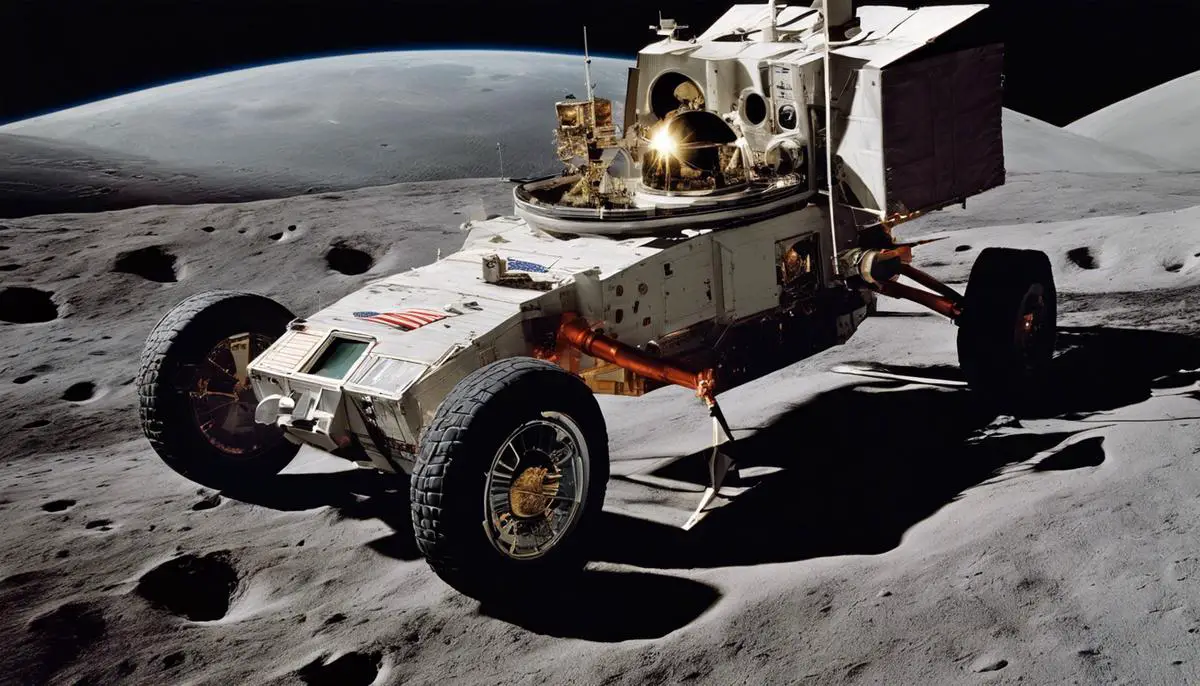In an age when human ambition dared to leap beyond terrestrial boundaries to touch the face of the moon, the Apollo program was born. A milestone of unmatched scale in human exploration and scientific advancement, this ambitious undertaking not only tested the limits of human capacity and intellect but also had remarkable economic implications. The provoking narrative of the Apollo missions gives an intriguing account of an era where an entire nation’s resources were directed at achieving one common objective. This paper delves deep into the economic landscape of the Apollo missions, offering a comprehensive study of the funding mechanisms involved, the role of technological and human capital investments, and the enduring economic impacts of this iconic space venture. Moreover, the paper provides a pivotal comparative analysis that bridges the economic aspect of Apollo missions with contemporary space programs, uncovering potential insights for future endeavors.
Contents
The Economic Impress of Apollo Program
A Significant Chronology: Economic Structure and Funding of the Apollo Program
NASA’s Apollo mission program, widely recognized as an emblematic testament to humankind’s relentless quest for knowledge, stands as an unparalleled scientific venture. This article demystifies the economic structure and funding methodology encapsulating this iconic journey from the earth to the moon.
In 1961, President John F. Kennedy broadcasted to the world America’s aspiration – “landing a man on the moon and returning him safely to the earth” before the end of the decade. His vision hinged on a monumental fiscal undertaking, a budget that highlighted the robust financial scaffolding required to underpin this mission. His grand dream sparked the genesis of the Apollo Program.
The Apollo Program seamlessly balances on two fundamental financial concepts: direct investment and public funding. For a program as expansive and resource-orientated as Apollo, direct government interest was critical. The federal government, instrumental in its financial support, directly allocated funds toward NASA, signifying clear consideration of America’s fiscal health.
The augmentation of NASA’s budget during the Apollo years provides an explicit reflection of that role. NASA’s budget increased by a staggering 500% two years after the Apollo Program’s commencement, reaching its zenith at $5.2 billion in 1965, an amount that constituted around 4.41% of the federal budget. This influx of capital allowed NASA to engage in the recruitment of personnel, procurement of necessary hardware and the infrastructural development imperative for the effort.
Moreover, the usage of public funding emerged as an interconnected strand helping to bolster the funding network. The costs of implementing the Apollo Program fell under the federal budget’s discretionary spending domain, hence, making it a very public fiscally-invested venture. As the populace’s collective taxes formed a crucial aspect of the budget, Apollo transcended from a mere government program to an ambition that was interconnected with every American citizen.
The Apollo Program’s costs eventually reached a staggering total of approximately $25.4 billion. Although it may seem a galactic sum, it is important to couch this expenditure within the economic benefits generated by the program. The technological innovation caused by this mission led to advanced development in areas such as integrated circuit technology and retractable spacecraft life-support systems.
The Apollo Program was a novel endeavor, not solely from a scientific and technological perspective but also from an economic facet. Its funding model, pivoting on government investment and public support, ensured a balanced economic backing for an audacious dream that resonates through the annals of history. It stands as a testament to the greatness that can be achieved when science, ingenuity, and public investment harmoniously intermingle.

Investment in Technology and Human Capital
With broad strokes having covered the initial concepts and economic implications of the Apollo Program, it behooves us to delve deeper into both the technical investments and human resource aspects. Indeed, each element was pivotal to the program’s success and eventual legacy, a tapestry intricately woven from threads of pioneering innovation and the indomitable human spirit.
In the realm of technology, the Apollo missions heralded a veritable revolution. They compelled the development of pioneering computing systems, fuel cells, and telecommunications infrastructure, among other things. The Lunar Module (LM), Earth and Command Module (CM) spacecraft, and the mighty Saturn V rocket- each an emblem of astronomical costs and a testament to technology’s relentless stride. IBM’s Instrument Unit, developed for Saturn V, can perhaps be attributed as the antecedent of modern computer systems, embodying a leap from rudimentary computing to digitization.
The Lunar Roving Vehicle, often colloquially known as the Moon Buggy, also marked a major technological investment. Crafted by Boeing and General Motors, this electric vehicle was essentially the first of its kind, allowing astronauts a wider range of exploration on the Moon’s surface – an ability that exponentially increased the scientific payload and the breadth of lunar data collected.
Tangentially, humans were the heart that made this technical body function. A consortium of over 400,000 brilliant minds, encompassing engineers, technicians, scientists, and astronauts echoed President Kennedy’s vision. Bayer, Chrysler, IBM, MIT, and several other renowned firms were contracted to bring this program to life, an allusion to how deeply the program permeated industrial America. The human resource costs, though vast, were equally pivotal in achieving the Apollo Program’s objectives.
Were these investments worth it, one might ponder? From a purely utilitarian perspective, the Apollo missions birthed numerous technological advancements, many of which we employ today. From integrated circuits and heat-resistant materials to advances in satellite technology, the benefits reaped are extraordinary and pervasive.
On another plane, these missions galvanized a generation into believing the ubiquity of human potential, painting tangible pictures of the ‘hitherto impossible’. The societal shift of viewing humanity as space explorers and valuing scientific curiosity was worth the Herculean financial and human investment.
Therefore, the worthwhile nature of the Apollo investment is found not only in the immense technological advancements, but also in the paradigm shift it induced in society’s mindset. The Apollo missions lighted the torch that continues to burn in today’s era of space exploration, making the most audacious dreams fathomable realities.

Long-term financial impacts of Apollo missions
Pivoting from the conceptualized roles and substantive details of the Apollo Program, including the human resources involved, potential partnerships, and innovative developments in technology, the subsequent exploration aims to extend the scope of the discussion towards the fiscal outcome from such concerted foray into the cosmos.
An aspect that cannot be overlooked in this context is the transformative impact of the Apollo missions on the U.S. economy. As per the study commissioned by NASA, the total Apollo expenditure of $25.4 billion during the 1960s stimulated an increased economic output worth $64.1 billion during the same period. These gains were reflected through a myriad of sectors, ranging from manufacturing, information services, to business services. This significant return on investment proves the effectiveness of such programs in fostering economic growth, as the gains more than offset the initial costs.
Delving deeper into the economic aftermath of the program, it is noteworthy that the Apollo missions generated robust employment. At its peak in 1965, about 34,000 NASA employees and 375,000 contractors were involved in the program, fostering job creation and fueling economic acceleration. Moreover, the contractors were spread across 20,000 firms, involving a wide swath of industries and regions, thereby spreading the economic benefits geographically and sectorally.
Moreover, the Apollo missions paved the way for further investments in the space industry, enabling its growth into a multi-billion dollar industry. With private firms, such as SpaceX and Blue Origin, entering this arena, the ongoing activity in the space economy would not have been imaginable without the precedent set by the Apollo missions.
The emphasis on science and technology presented by the Apollo Program also led to a rising interest in scientific education. The ‘Apollo effect,’ as it is referred to, ushered in substantial increases in Ph.D. awards in the physical sciences, engineering, and other relevant fields during the 1960s and 70s. This, in turn, catered to technological advancements in various sectors, fostering innovation, increasing productivity, and propelling economic growth.
On the macroeconomic side, the fiscal stimulus provided by the Apollo Program served as an efficacious countercyclical tool during periods of economic downturn, helping to sustain economic activity levels.
In the realm of international competition, the unequivocal statement of technological prowess that the Apollo missions represented helped secure the U.S.’s global standing during the Cold War period. This dominance in space research propelled the American economy by promoting the nation as an advanced technological hub, attracting global investments.
The commercial and financial benefits yielded by the Apollo Program, thus, supplemented its intrinsic scientific and exploration-based achievements. Spurring economic growth, fostering job creation, catalyzing sectoral advancements, bringing educational enhancements, and improving international stature – the Apollo missions’ impact on the American economy goes beyond the mere numbers, profoundly pervading the socio-economic fabric of the nation.

Comparative Cost Analysis
Pivoting the lens to our present landscape of space exploration, the cost dynamics have seen a tectonic shift from the era of Apollo missions
.In the current milieu, distinct funding models have emerged, challenging the sterling paradigm set by the richly funded Apollo missions. Notably, the trend of privatization has gleaned the limelight in the present-day space endeavours, featuring preeminent names such as SpaceX and Blue Origin.
The rise of these commercial private entities has substantively reshaped the cost structure of space tasks. SpaceX’s Falcon 9, a launch vehicle crafted for the modern age, represents this transition with aplomb—being reusable and hence opening avenues for considerable cost reduction. As per SpaceX, Falcon 9’s cost per launch comes to around $62 million, a significant contrast to the traditional, more cost-intensive space missions.
This newer, more capital-efficient model has its roots in technological evolution as well as shifts in funding sources. Whereas Apollo missions were solely funded through public money, contemporary space actors receive funds from diverse channels—private investments, commercial contracts, and indeed, a reduced, yet still significant federal backing.
The Mars Rover missions, operated by NASA, offer another benchmark of modern space endeavours. The price tag for these ventures has fallen within the one to two billion dollars range, with the Mars Perseverance rover’s total cost hovering around $2.7 billion. When one considers the extended timelines, the advancement in technology, the multiplicity of the rovers’ scientific goals, the costs seem justified in comparison.
The International Space Station (ISS), a marvel in the realm of modern space exploration, comes with a massive cost exceeding $150 billion. It is worth noting, however, that the ISS’s costs are not borne by a single country; instead, they are shared among the 15 nations involved in this grand project. Spanning decade-long construction and continuous operation, the ISS represents a different approach to funding and undertaking space exploration—international collaboration.
Comparing these disparate models of space programs from different epochs can often prove challenging due to the myriad variables involved. Inflation, for instance, adjusts the Apollo Program’s cost upwards of $260 billion in today’s terms, a gargantuan sum indeed.
Yet, when cost comparisons are brought into the ambit, it is worthwhile to avoid getting ensnared in a simplistic dollar for dollar evaluation. The profound impacts of such missions—be they the Apollo moon landings or the research being carried out aboard the ISS—transcend mere economic ramifications. Their true value resides in advancing the frontiers of human knowledge, fostering technological leaps, and their inspirational power that knows no bounds.
The costs of the Apollo missions and the present-day space endeavors reveal a story of evolution and adaptability in science’s pursuit—transforming from single-nation, public-funded behemoth projects to shared ventures incorporating commercial actors, private investments, and international partnerships. In conclusion, the price for space exploration remains high, but its benefits perfectly justify it, for they are, in the final analysis, epochal, pervading, and immeasurable.

Reflecting back on Apollo missions’ soaring scale, the intertwined layers of economics, technology, human capital, and even national pride spin an intriguing narrative. The long-term impacts of these missions, quantifiable in economic growth, advancements across industries, and unexpected revenue streams, remain persistent in modern society, an everlasting testament to human ingenuity. The fascinating quest doesn’t end at analyzing Apollo missions alone. Putting these costs into perspective by comparing them with modern space ventures reveals the evolving inherent efficiency of space exploration endeavors, an insight that might hold the key to planning and budgeting future missions. This narrative thus positions Apollo missions not just as awe-inspiring historical events, but as enduring influencers that continue to guide and shape our economic, technological, socio-cultural, and intellectual trajectories.
